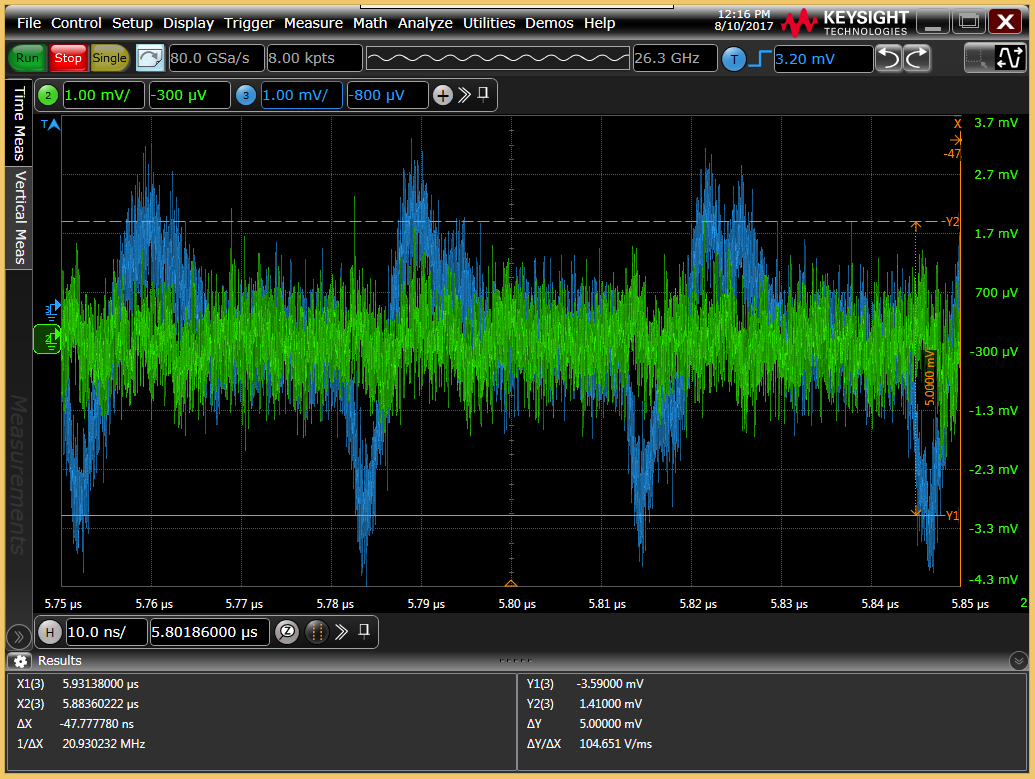Analysis of RasbPi Clocks
The actual chip under scrutiny is the Atmega 168/328 timer
According to docs Pwm exists on pairs [5, 6], [3, 9], [10, 11]
Upon investigation a 6ns offset occurs from measuring unmatched signals because the physical groups are actually [9,10], [3,11], and [5,6]
According to https://playground.arduino.cc/Code/PwmFrequency
5 and 6 @ 62500 Hz 3, 9, 10, 11 @ 31250 Hz
However on the analogWrite page it claims output 5,6 @ 980 Hz. I’m uniquely suited to find out what the clock speeds are at various settings, take images of how the pwm is actually occurring, what the waveforms look like, and detail some physical characteristics are of the signal.
In what is certainly overkill for this project I’ll be using the Agilent infinium DSA-92504A
and measuring with a TEK P6139A Voltage Probe (500MHz, 8pF, 10 MOhm 10X, 1.3 m)
These are differential probes, and I’ll be using ground as reference
(Thumb of setup) Assume that all connections are terminated in 50 Ohm
So, first things first, we should have 2 different clock rates between [5,6] and [3,9,10,11] so let’s check that by probing 5 and 11. Visually we can see they differ by ABOUT a factor of 2, but it’s not quite that perfect and since the difference is not an integer number (or not a clean clock) the signals are not in sync. If they are indeed designed to be exactly a factor of 2 apart there must be some periodic Jitter (PJ) keeping the signals from lining up consistently (got lucky in this screenshot)
I want to know if the clocks which are the same frequency pins (5,6 in this case) are in sync. The pairs all look generally like below.They seem to be very close, but with this equipment I can see differences of a few picoseconds, but we’ll dig into that in a minute by zooming into the signals.
It looks like they always stay synced at all times.
Lets move on from 50% duty cycle and check out what the min period of the duty cycle is, so I change the duty cycle to the minimum value 1/255 At this point the signals become 0.39% active and since the clocks at different frequencies will trigger at different times I have to do them one at a time. So in the screenshot just for pin 11
we can see the pulse lasts about 8 micro sec. If we assume this is the minimum toggle time for the signal, this is the clock speed. Taking the duration of the pulse as one clock cycle results in a freq of ABOUT 125kHz= 1 / 8e-6s. Hmm. That's about twice the speed that this clock should be.
As it turns out it’s not quite that simple. We’re being limited by the analogWrite interface to only 1/225 resolution. When I measure the other signals [5,6] it also measures in at 8 us which makes given the resolution limit of the interface.
When I zoom there is no skew/lag between them, and when I REALLY zoom I start to see some interesting variations.
I’ve not mentioned amplitude yet, but it bears noting that HIGH is 5.55mV and a low is ~2.4mV, so it’s really interesting to me how the start of the “high” segment is prefaced with a 200mV overshoot. This must be a signal (from what to what)l to start, because it seems ridiculous as an overshoot value of 40 times greater than the typical level. It’s probably also worth noting that the power is coming from a laptop, and there may be some noise associated with that as well. Let’s use wall power instead just in case.
Now on wall power and back to pins [10,11] to investigate the signal properties of this 6us offset that doesn’t exist on the [9,3] or [5,6] lines. I decided to get a screenshot of the voltage artifacts suggesting that the signals are on related circuits. It’s hard to tell what the signal is here because we are so zoomed out to be able to see the spike, but this is 6ms into the signal. Where green is transitioning to an on state. Even tho the blue signal has already been outputting, there is still a lot of noise (and bounce) caused by the signal.
First we’ll look where the blue signal (pin 10) where the duty cycle begins with a 175 mv peak and then settles back to normal high state voltage of 6mV in about 50ns.
It’s really interesting to me how the green signal of pin 9 responds to this impulse. It peaks at about 22 mV and eventually settles back to it’s low level.
Now onto where the green signal (pin 11) begins transmitting power, it peaks at 150mV and settles in a bit less than 50ns. The signal itself is very irregular looking. So let’s check it out
Here the cursors are set to show voltage peaks (dY= 7mv)
Here i’m showing the difference between a low, and a high signal. The cursors are set at the average value of the blue signal (5mV)






